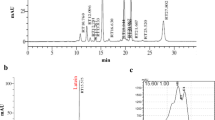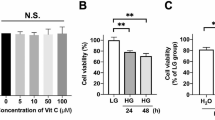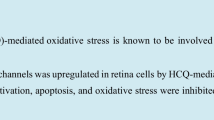Abstract
Purpose
The concentration of plasma high glucose (HGu) in diabetes mellitus (DM) induces the retinal pigment epithelial cell (ARPE19) death via the increase of inflammation, cytosolic (cytROS), and mitochondrial (mitROS) free oxygen radical generations. Transient potential melastatin 2 (TRPM2) cation channel is stimulated by cytROS and mitROS. Hence, the cytROS and mitROS-mediated excessive Ca2+ influxes via the stimulation of TRPM2 channel cause to the induction of DM-mediated retina oxidative cytotoxicity. Because of the antioxidant role of carvacrol (CRV), it may modulate oxidative cytotoxicity via the attenuation of TRPM2 in the ARPE19. We aimed to investigate the modulator action of CRV treatment on the HGu-mediated TRPM2 stimulation, oxidative stress, and apoptosis in the ARPE19 cell model.
Material and methods
The ARPE19 cells were divided into four groups as normal glucose (NGu), NGu + Carv, HGu, and HGu + CRV.
Results
The levels of cell death (propidium iodide/Hoechst rate) and apoptosis markers (caspases 3, 8, and 9), cytokine generations (IL-1β and TNF-α), ROS productions (cytROS, mitROS, and lipid peroxidation), TRPM2 currents, and intracellular free Ca2+ (Fluo/3) were increased in the HGu group after the stimulations of hydrogen peroxide and ADP-ribose, although their levels were diminished via upregulation of glutathione and glutathione peroxidase by the treatments of CRV and TRPM2 blockers.
Conclusion
Current results confirmed that the HGu-induced overload Ca2+ influx and oxidative retinal toxicity in the ARPE19 cells were induced by the stimulation of TRPM2, although they were modulated via the inhibition of TRPM2 by CRV. CRV may be noted as a potential therapeutic antioxidant to the TRPM2 activation-mediated retinal oxidative injury.









Similar content being viewed by others
Data availability
The data analyses in the current study were performed in the BSN Health, Analyses, Innov., Consul., Org., Agricul. and Industry Ltd (Isparta, Turkey) https://www.bsnsaglik.com.tr/. The details of current analyses are available from Prof. Dr. M. Nazıroğlu on reasonable request.
Abbreviations
- 2APB:
-
2-Aminoethoxydiphenyl borate
- ACA:
-
N-(p-amylcinnamoyl)anthranilic acid
- ADPR:
-
ADP-ribose
- ARPE19:
-
Adult retinal pigment epithelial 19
- BF:
-
Bright field
- Ca2+ :
-
Calcium ion
- CASP/3:
-
Caspase 3
- CASP/8:
-
Caspase 8
- CASP/9:
-
Caspase 9
- CLSM:
-
Confocal laser scanning microscope
- CRV:
-
Carvacrol
- cytCa2+ :
-
Cytosolic free calcium ion
- cytROS:
-
Cytosolic free reactive oxygen radicals
- cytZn2+ :
-
Cytosolic free Zn2+
- DM:
-
Diabetes mellitus
- DRG:
-
Dorsal root ganglion
- ROS:
-
Free reactive oxygen radicals
- GPx:
-
Glutathione peroxidase
- HGu:
-
High glucose
- LPO:
-
Lipid peroxidation
- mitROS:
-
Mitochondrial free reactive oxygen radicals
- mitMP:
-
Mitochondrial membrane potential
- NGu:
-
Normal glucose
- PARP1:
-
Poly [ADP-ribose] polymerase 1
- SERCA:
-
Sarco(endo)plasmic reticulum Ca2+-ATPase
- TRP:
-
Transient receptor potential
- TRPM2 :
-
Transient receptor potential melastatin 2
References
Buch H, Vinding T, La Cour M, Appleyard M, Jensen GB, Nielsen NV (2004) Prevalence 9 and causes of visual impairment and blindness among 9980 Scandinavian adults: The 10 copenhagen city eye study. Ophthalmology 111:53–61
Quartilho A, Simkiss P, Zekite A, Xing W, Wormald R, Bunce C (2016) Leading causes of certifiable visual loss in England and Wales during the year ending 31 March. Eye (Lond) 30(4):602–607. https://doi.org/10.1038/eye.2015.288
Calderon GD, Juarez OH, Hernandez GE, Punzo M, De la Cruz ZD (2017) Oxidative stress and diabetic retinopathy: development and treatment. Eye (Lond) 31(8):1122–1130. https://doi.org/10.1038/eye.2017.64
Tsai FJ, Li TM, Ko CH et al (2017) Effects of Chinese herbal medicines on the occurrence of diabetic retinopathy in type 2 diabetes patients and protection of ARPE-19 retina cells by inhibiting oxidative stress. Oncotarget. 8(38): 63528–63550. https://doi.org/10.18632/oncotarget.18846
van der Schaft N, Schoufour JD, Nano J et al (2019) Dietary antioxidant capacity and risk of type 2 diabetes mellitus, prediabetes and insulin resistance: The rotterdam study. Eur J Epidemiol 34:853–861. https://doi.org/10.1007/s10654-019-00548-9
Sun H, Zhao H, Yan Z, Liu X, Yin P, Zhang J (2021) Protective role and molecular mechanism of action of Nesfatin-1 against high glucose-induced inflammation, oxidative stress and apoptosis in retinal epithelial cells. Exp Ther Med 22(2):833. https://doi.org/10.3892/etm.2021.10265
Madsen-Bouterse SA, Kowluru RA (2008) Oxidative stress and diabetic retinopathy: pathophysiological mechanisms and treatment perspectives. Rev Endocr Metab Disord 9(4):315–327. https://doi.org/10.1007/s11154-008-9090-4
Eshaq RS, Wright WS, Harris NR (2014) Oxygen delivery, consumption, and conversion to reactive oxygen species in experimental models of diabetic retinopathy. Redox Biol 2:661–666. https://doi.org/10.1016/j.redox.2014.04.006
Kahya MC, Nazıroğlu M, Övey İS (2017) Modulation of diabetes-induced oxidative stress, apoptosis, and Ca2+ entry through TRPM2 and TRPV1 channels in dorsal root Ganglion and hippocampus of diabetic rats by melatonin and selenium. Mol Neurobiol 54(3):2345–2360. https://doi.org/10.1007/s12035-016-9727-3
Park J, Kim H, Park SY et al (2014) Tonicity-responsive enhancer binding protein regulates the expression of aldose reductase and protein kinase C δ in a mouse model of diabetic retinopathy. Exp Eye Res 122:13–19. https://doi.org/10.1016/j.exer.2014.03.001
Tang WH, Cheng WT, Kravtsov GM et al (2010) Cardiac contractile dysfunction during acute hyperglycemia due to impairment of SERCA by polyol pathway-mediated oxidative stress. Am J Physiol Cell Physiol 299(3):C643–C653. https://doi.org/10.1152/ajpcell.00137.2010
Mahmoud AM, Abd El-Twab SM, Abdel-Reheim ES (2017) Consumption of polyphenol-rich Morus alba leaves extract attenuates early diabetic retinopathy: the underlying mechanism. Eur J Nutr 56(4):1671–1684. https://doi.org/10.1007/s00394-016-1214-0
Al-Kharashi AS (2018) Role of oxidative stress, inflammation, hypoxia and angiogenesis in the development of diabetic retinopathy. Saudi J Ophthalmol 32(4):318–323. https://doi.org/10.1016/j.sjopt.2018.05.002
Nazıroğlu M, Dikici DM, Dursun S (2012) Role of oxidative stress and Ca2+ signaling on molecular pathways of neuropathic pain in diabetes: focus on TRP channels. Neurochem Res 37(10):2065–2075. https://doi.org/10.1007/s11064-012-0850-x
Koivisto AP, Belvisi MG, Gaudet R, Szallasi A. (2021) Advances in TRP channel drug discovery: from target validation to clinical studies. Nat Rev Drug Discov 2021 15:1–19. Epub ahead of print. https://doi.org/10.1038/s41573-021-00268-4
Hara Y, Wakamori M, Ishii M et al (2002) LTRPC2 Ca2+-permeable channel activated by changes in redox status confers susceptibility to cell death. Mol Cell 9(1):163–173. https://doi.org/10.1016/s1097-2765(01)00438-5
Nazıroğlu M, Lückhoff A (2008) A calcium influx pathway regulated separately by oxidative stress and ADP-Ribose in TRPM2 channels: single channel events. Neurochem Res 33(7):1256–1262. https://doi.org/10.1007/s11064-007-9577-5
Uchida K, Tominaga M (2014) The role of TRPM2 in pancreatic β-cells and the development of diabetes. Cell Calcium 56(5):332–339. https://doi.org/10.1016/j.ceca.2014.07.001
Yosida M, Dezaki K, Uchida K et al (2014) Involvement of cAMP/EPAC/TRPM2 activation in glucose- and incretin-induced insulin secretion. Diabetes 63(10):3394–3403. https://doi.org/10.2337/db13-1868
Sözbir E, Nazıroğlu M (2016) Diabetes enhances oxidative stress-induced TRPM2 channel activity and its control by N-acetylcysteine in rat dorsal root ganglion and brain. Metab Brain Dis 31(2):385–393. https://doi.org/10.1007/s11011-015-9769-7
Saadane A, Du Y, Thoreson WB et al (2021) Photoreceptor cell calcium dysregulation and calpain activation promote pathogenic photoreceptor oxidative stress and inflammation in prodromal diabetic retinopathy. Am J Pathol 191(10):1805–1821. https://doi.org/10.1016/j.ajpath.2021.06.006
Shoorei H, Khaki A, Khaki AA, Hemmati AA, Moghimian M, Shokoohi M (2019) The ameliorative effect of carvacrol on oxidative stress and germ cell apoptosis in testicular tissue of adult diabetic rats. Biomed Pharmacother 111:568–578. https://doi.org/10.1016/j.biopha.2018.12.054
Custódio JB, Ribeiro MV, Silva FS, Machado M, Sousa MC (2011) The essential oils component p-cymene induces proton leak through Fo-ATP synthase and uncoupling of mitochondrial respiration. J Exp Pharmacol 3:69–76. https://doi.org/10.2147/JEP.S16387
Gatica S, Eltit F, Santibanez JF, Varela D, Cabello-Verrugio C, Simon F (2019) (2019) Expression suppression and activity inhibition of TRPM7 regulate cytokine production and multiple organ dysfunction syndrome during endotoxemia: a new target for sepsis. Curr Mol Med 19(8):547–559. https://doi.org/10.2174/1566524019666190709181726
Deng W, Lu H, Teng J (2013) Carvacrol attenuates diabetes-associated cognitive deficits in rats. J Mol Neurosci 51(3):813–819. https://doi.org/10.1007/s12031-013-0069-6
Arkali G, Aksakal M, Kaya ŞÖ (2021) Protective effects of carvacrol against diabetes-induced reproductive damage in male rats: modulation of Nrf2/HO-1 signalling pathway and inhibition of Nf-kB-mediated testicular apoptosis and inflammation. Andrologia 53(2):e13899. https://doi.org/10.1111/and.13899
Hong DK, Choi BY, Kho AR et al (2018) Carvacrol attenuates hippocampal neuronal death after global cerebral ischemia via inhibition of transient receptor potential melastatin 7. Cells 7(12):231. https://doi.org/10.3390/cells7120231
Xie P, Fujii I, Zhao J, Shinohara M, Matsukura M (2012) A novel polysaccharide compound derived from algae extracts protects retinal pigment epithelial cells from high glucose-induced oxidative damage in vitro. Biol Pharm Bull 35(9):1447–1453. https://doi.org/10.1248/bpb.b110706
Li H, Li R, Wang L, Liao D, Zhang W, Wang J (2021) Proanthocyanidins attenuate the high glucose-induced damage of retinal pigment epithelial cells by attenuating oxidative stress and inhibiting activation of the NLRP3 inflammasome. J Biochem Mol Toxicol 35(9):e22845. https://doi.org/10.1002/jbt.22845
Meléndez García R, Arredondo Zamarripa D, Arnold E et al (2016) Prolactin protects retinal pigment epithelium by inhibiting sirtuin 2-dependent cell death. EBioMedicine 7:35–49. https://doi.org/10.1016/j.ebiom.2016.03.048
Özkaya D, Nazıroğlu M (2021) Bevacizumab induces oxidative cytotoxicity and apoptosis via TRPM2 channel activation in retinal pigment epithelial cells: Protective role of glutathione. Graefes Arch Clin Exp Ophthalmol 259(6):1539–1554. https://doi.org/10.1007/s00417-021-05074-7
Özkaya D, Shu X, Nazıroğlu M (2021) Deletion of mitochondrial translocator protein (TSPO) gene decreases oxidative retinal pigment epithelial cell death via modulation of TRPM2 channel. Biology (Basel) 10(5):382. https://doi.org/10.3390/biology10050382
Chenet AL, Duarte AR, de Almeida FJS, Andrade CMB, de Oliveira MR (2019) Carvacrol depends on heme oxygenase-1 (HO-1) to exert antioxidant, anti-inflammatory, and mitochondria-related protection in the human neuroblastoma SH-SY5Y cells line exposed to hydrogen peroxide. Neurochem Res. 44(4):884–896. https://doi.org/10.1007/s11064-019-02724-5
McHugh D, Flemming R, Xu SZ, Perraud AL, Beech DJ (2003) Critical intracellular Ca2+ dependence of transient receptor potential melastatin 2 (TRPM2) cation channel activation. J Biol Chem 278(13):11002–11006. https://doi.org/10.1074/jbc.M210810200
Özkaya D, Nazıroğlu M, Vanyorek L, Muhamad S (2021) Involvement of TRPM2 channel on hypoxia-induced oxidative injury, inflammation, and cell death in retinal pigment epithelial cells: modulator action of selenium nanoparticles. Biol Trace Elem Res 199(4):1356–1369. https://doi.org/10.1007/s12011-020-02556-3
Bejarano I, Espino J, Marchena AM et al (2011) Melatonin enhances hydrogen peroxide-induced apoptosis in human promyelocytic leukaemia HL-60 cells. Mol Cell Biochem 353(1–2):167–176. https://doi.org/10.1007/s11010-011-0783-8
Kalyanaraman B, Darley-Usmar V, Davies KJ et al (2012) Measuring reactive oxygen and nitrogen species with fluorescent probes: challenges and limitations. Free Radic Biol Med 52(1):1–6. https://doi.org/10.1016/j.freeradbiomed.2011.09.030
Sivandzade F, Bhalerao A, Cucullo L. (2019) Analysis of the mitochondrial membrane potential using the cationic JC-1 dye as a sensitive fluorescent probe. Bio Protoc. 9(1): e3128. https://doi.org/10.21769/BioProtoc
Özkaya D, Nazıroğlu M, Armağan A et al (2011) Dietary vitamin C and E modulates oxidative stress induced-kidney and lens injury in diabetic aged male rats through modulating glucose homeostasis and antioxidant systems. Cell Biochem Funct 29(4):287–293
Chang YS, Lin CF, Wu CL et al (2011) Mechanisms underlying benzyl alcohol cytotoxicity (triamcinolone acetonide preservative) in human retinal pigment epithelial cells. Invest Ophthalmol Vis Sci 52(7):4214–4222. https://doi.org/10.1167/iovs.10-6058
Lin YC, Shen ZR, Song XH, Liu X, Yao K (2018) Comparative transcriptomic analysis reveals adriamycin-induced apoptosis via p53 signaling pathway in retinal pigment epithelial cells. J Zhejiang Univ Sci B 19(12):895–909. https://doi.org/10.1631/jzus.B1800408
Song J, Lee SC, Kim SS et al (2004) Zn2+-induced cell death is mediated by the induction of intracellular ROS in ARPE-19 cells. Curr Eye Res 28(3):195–201. https://doi.org/10.1076/ceyr.28.3.195.26251
Nazıroğlu M (2007) New molecular mechanisms on the activation of TRPM2 channels by oxidative stress and ADP-ribose. Neurochem Res 32(11):1990–2001
Perraud AL, Fleig A, Dunn CA et al (2001) ADP-ribose gating of the calcium-permeable LTRPC2 channel revealed by Nudix motif homology. Nature 411(6837):595–599. https://doi.org/10.1038/35079100
Han D, Wu X, Liu L, Shu W, Huang Z (2018) Sodium tanshinone IIA sulfonate protects ARPE-19 cells against oxidative stress by inhibiting autophagy and apoptosis. Sci Rep 8(1):15137. https://doi.org/10.1038/s41598-018-33552-2
Nazıroğlu M. (2021) A novel antagonist of TRPM2 and TRPV4 channels: carvacrol. Metab Brain Dis. https://doi.org/10.1007/s11011-021-00887-1
Cui ZW, Xie ZX, Wang BF et al (2015) Carvacrol protects neuroblastoma SH-SY5Y cells against Fe(2+)-induced apoptosis by suppressing activation of MAPK/JNK-NF-κB signaling pathway. Acta Pharmacol Sin 36(12):1426–1436. https://doi.org/10.1038/aps.2015.90
Armağan HH, Nazıroğlu M (2021) Glutathione depletion induces oxidative injury and apoptosis via TRPM2 channel activation in renal collecting duct cells. Chem Biol Interact 334:109306. https://doi.org/10.1016/j.cbi.2020.109306
Belrose JC, Xie YF, Gierszewski LJ, MacDonald JF, Jackson MF (2012) Loss of glutathione homeostasis associated with neuronal senescence facilitates TRPM2 channel activation in cultured hippocampal pyramidal neurons. Mol Brain 5:11. https://doi.org/10.1186/1756-6606-5-11
Baser KHC (2008) Biological and pharmacological activities of carvacrol and carvacrol bearing essential oils. Curr Pharm Des 14:3106–3120
Lyu Q, Ludwig IS, Kooten PJS, Sijts AJAM, Rutten VPMG, van Eden W, Broere F (2020) Leucinostatin acts as a co-inducer for heat shock protein 70 in cultured canine retinal pigment epithelial cells. Cell Stress Chaperones 25(2):235–243. https://doi.org/10.1007/s12192-019-01066-z
Li Y, Mai Y, Qiu X et al (2020) Effect of long-term treatment of Carvacrol on glucose metabolism in Streptozotocin-induced diabetic mice. BMC Complement Med Ther 20(1):142. https://doi.org/10.1186/s12906-020-02937-0
Kaymaz A, Ulaş F, Çetinkaya A, Erimşah S (2021) Investigating the effects of carvacrol in rats using oxygen-induced retinopathy model. Indian J Ophthalmol 69(5):1219–1223. https://doi.org/10.4103/ijo.IJO_1935_20
Acknowledgements
The authors would like to thank Dr. Xinhua Shu for his valuable contributions to preparation of ARPE19 cells.
Funding
The study was performed with a financial support of the company (BSN Health) (Project No: 2021–03. Project owner: Dr. Hatice Daldal).
Author information
Authors and Affiliations
Contributions
H Daldal: The design, data analyses, manuscript preparation, conception, and critical revision of present study. M. Nazıroğlu: The analyses and preparation of figures in the manuscript. The manuscript submission was approved by both authors.
Corresponding author
Ethics declarations
Ethical approval
Samples from human participants and experimental animals were not used in the present study by any of the authors.
Conflict of interest
The authors declare no competing interests.
Additional information
Publisher's note
Springer Nature remains neutral with regard to jurisdictional claims in published maps and institutional affiliations.
Rights and permissions
About this article
Cite this article
Daldal, H., Nazıroğlu, M. Carvacrol protects the ARPE19 retinal pigment epithelial cells against high glucose-induced oxidative stress, apoptosis, and inflammation by suppressing the TRPM2 channel signaling pathways. Graefes Arch Clin Exp Ophthalmol 260, 2567–2583 (2022). https://doi.org/10.1007/s00417-022-05731-5
Received:
Revised:
Accepted:
Published:
Issue Date:
DOI: https://doi.org/10.1007/s00417-022-05731-5




